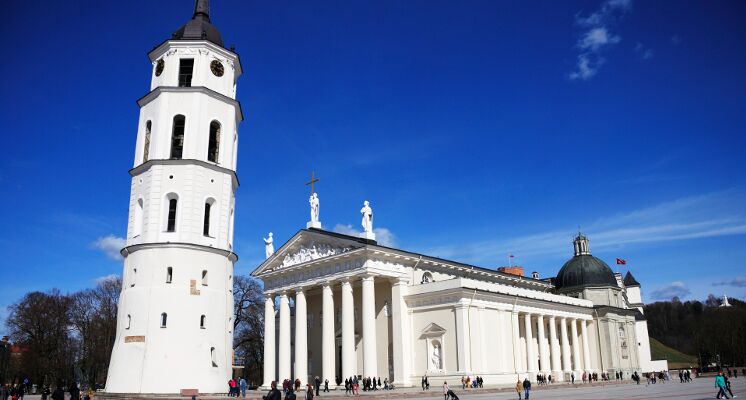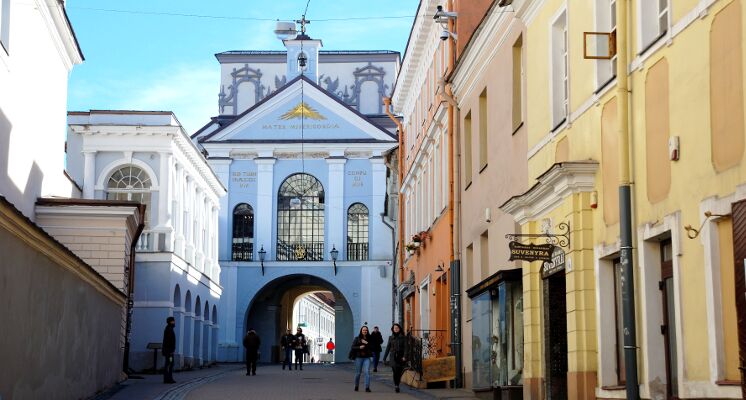Lithuania, a little, but proud and brave state, located near the Baltic Sea, during the history of statehood from XIII ct. is thought to have had four capitals: Vilnius, Trakai, Kernave and Kaunas. But Vilnius was the first capital and, from the very beginning, have always been the main capital of the country. Vilnius is interesting not only for its great political and cultural significance, but also for several other uniqueness.
First, we could hardly find many cities in the world, where Mother Nature with its hills, pineries and redolent birches would march directly to the center of the city, would not get afraid of its noise and managed to stay such natural and wild. It is a real phenomenon in urbanistics. The Old town of Vilnius – unique place and for the especial harmony of “nature and stone”, what is not characteristically to medieval town.
Second, Vilnius has one of the biggest Old towns, compared to other towns of Eastern Europe. Starting it’s history of formation from the XIV th century in the left bank of river Neris, to the South from Gediminas hill, in the XVI th century one square kilometer-size town was framed by the defensive wall – for these times it was incredibly big area for the town. Today Old town of Vilnius occupies the area of 3,51 ha.
Third, while in Old town we can find examples of almost all architectural styles, Vilnius is being called “the town of baroque”. It is worth to mention, that Vilnius is the most north side town from the Alps, in which baroque holds the dominant position in the architecture. For this reason Vilnius sometimes is called “Little Rome”.
Fourth, specific view of Old town of Vilnius also had been formed by it’s multicultural environment. From the old times people of different nationalities, cultures or religions could find a safe haven in Vilnius. This contributed much to the prosperity and fast development of the town.
What is more, the Old town of Vilnius has one more specific feature – affluence of perspectives. We could hardly find two different places, leading to the same perspective (view). So try to “catch” these picturesque views, while in Vilnius.
For it’s uniqueness, Old town of Vilnius was included into the list of World heritage of UNESCO in year 1994. In UNESCO documents, three reasons of including Vilnius in the list mentioned were outlined. First, Vilnius is the most Eastern town of Central Europe, in which strong interaction of Western and Eastern cultures was observed. Second, Vilnius has saved medieval-style net of streets and system of buildings. Third, from XIV ct. till the end of XVII ct. Vilnius made significant influence for the cultural life in the region.
How this unique town has formed? The formation of Vilnius from the very beginning was determined by the erosion processes, caused by two rivers – Neris and Vilnele, because of witch at the intersection of two rivers wide valley was formed. Neris is dividing the town into two parts – old and new. Alongside banks of Vilnele first buildings of primary importance were situated. Town is surrounded by comparatively high hills - Šeškinės in the North, Antakalnio and Belmonto – in the East, Markučių, Liepkalnio, Rasų – in the South, Vingrių, Velnių, Panerių ir Karoliniškių – in the West. Old town is situated on the small terraces, which are slowly going down to Neris and Vilnelė.
The development of the town has started in XIV century from the three castles – Upper castle, Royal palace and Crooked castle. The development of town was accelerated after granting the Privileges of Magdeburg (self-government) by Jogaila in 1387 (after baptizing Lithuania). After this second nucleus of the further formation of the town appeared – City hall with a market square. Second grand stage of development of the town is considered the ruling of the last duke from the dynasty of Jogailaičiai Žygimantas Augustas in the middle of XVI century. At this time big estate of the Grand duke and even bigger needs lead to the prosperity of trade, what made favorable conditions for a capital accumulation and construction of new buildings.
Nowadays Vilnius has grown from the town, covering an area of one square kilometer in XVI ct to the contemporary city, covering area of 401 square kilometers and permanently expanding. Vilnius has about 550 mln. of inhabitants. What is interesting, nevertheless Lithuania is very homogeneous, Vilnius has saved it’s multinational character: 57.8% of inhabitants of the city are Lithuanians, 18.7% Poles, 14% Russians, 4.0% Belarusians, 1.3% Ukrainians and 0.5% Jews.
About us
Contacts
All rights reserved | Vivid Vilnius Belongs to VšĮ "Ekskursijos Vilniuje" į.k. 304215124



